No Audio in Game Stray? Try these fixes
Stray not outputting any audio or outputting stuttery sound could be caused due to multiple issues; before jumping into the solutions, take a glance over the causes we have gathered after a thorough investigation of this issue.

Here are a few causes that we think might be causing you to face this issue.
- Incorrect output Selected- It is possible that the output device selected is not the correct one; it is a common error and can easily be taken care of.
- Incompatible Sound Sample rate- Some applications require a higher sound sample rate, basically the rate at which sound samples are taken. Some instruments and sounds require a higher sound sample rate to prevent aliasing problems.
- Enabled Spatial sound- Reportedly, enabled spatial sound settings in the windows settings have caused players of stray to face similar issues. Some applications support spatial sound natively.
- Intervention from background services- In such a scenario, it is advised to clean boot your computer to identify if service from the background is intervening with other processes.
- Outdated Drivers- Another possibility is that your computer’s sound drivers are unstable or outdated; reinstalling or updating new ones should do the trick.
- Corrupt Game Files- It is possie that the problem lies in the game files; corrupt game files could lead to such problems.
1. Select Correct Output device
It is possible that the output device selected in the Windows settings might not be the correct one or the one it needs to be; follow these steps to select the correct output device in the windows settings:
- Press the Windows Key to open the windows start menu and click on the Settings icon or alternatively press the Windows + I keys to open the settings.

Selecting the correct output device - Click on System.
- Now, in the menu situated on the left side of your screen. Click on Sound.

Selecting the correct output device - Under the sound output heading, Select your Output device.
Once done, try launching stray. If the issue persists, continue to the next step.
2. Configure Sound Sample Rate
For users experiencing stuttering audio issues with stray, it is quite adequate to assume it is due to a mismatched sound sample rate. It is advised to set your computer sample sound rate to 48,000/44,000 Hz as a higher sound sample rate assures an increase in sound quality. Follow these steps to configure your computers sound sample rate:
- Press the Windows key to open the start menu and click on the Settings icon, or alternatively, Press the Windows + I key to open settings via shortcut.

Configuring the correct Sound sample rate - Click on the Systems box.
- In the panel on your screen’s left side, Locate and click on Sound.
- Now click on the Sound Control Panel on the top-right of your screen, as shown in the image.

Configuring the correct Sound sample rate - Select Playback from the navigation menu at the top of the newly opened window.
- Click on the Properties button.

Configuring the correct Sound sample rate - After that, Click on the Advanced tab located in the navigation menu.
- Now, Click on the Sample rate dropdown menu and select the 24 Bit, 48,000 Hz (Studio Quality) option from the list.
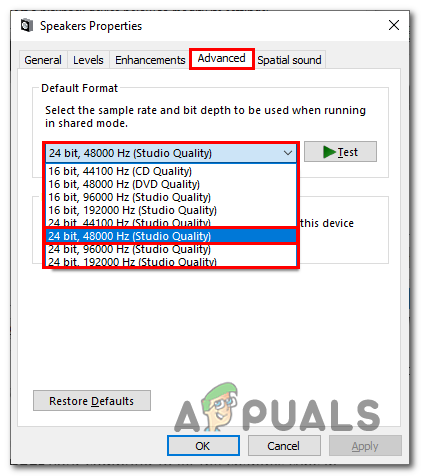
Configuring the correct Sound sample rate - Once Selected, Hit Apply and Ok.
- Reboot your computer to let the changes sync in.
Once rebooted, Try launching stray. If the issue presumes, continue to the next step.
3. Clean boot your Computer
Clean booting your computer means booting your computer in a state where the least possible amount of services is functioning in the background. It will help us identify if the issue is due to a problem related to an intervention from a background service. Follow these straightforward steps to clean boot your computer:
- Press the Windows key to open the start menu, and in the start menu search bar, type System Configuration.

Clean booting your computer - In the new window that opened, Click on the Services tab in the navigation menu.
- Now, On the bottom-right click on Hide all Microsoft services.
- After that, Click on Disable all.

Clean booting your computer - Hit the Ok button
- Restart your Computer.
Once restarted, try launching stray to check if the issue has been resolved or not. If the error presumes, continue to the next step.
4. Update Sound Drivers
Your computer’s sound drivers might be outdated; manufacturers launch new updates every now and then that solve previously discovered bugs. It is advised to keep your drivers up-to-date. Follow these straightforward steps to update your sound drivers:
4.1 Update via Device Manager
There are multiple ways to update your audio drivers on a windows machine; one of them is to update using the windows device manager. For most cases, this method is more than enough. Follow these steps to update your audio drivers on a windows machine:
- Right-Click on the Windows icon situated on the bottom-left of your screen.
- Click on the Device Manager button to open the device manager.

Updating audio drivers using device manager - Under the Sound, video and game controllers section, Right-click on your audio interface device.
- Click on Update drivers to initiate the driver update process.
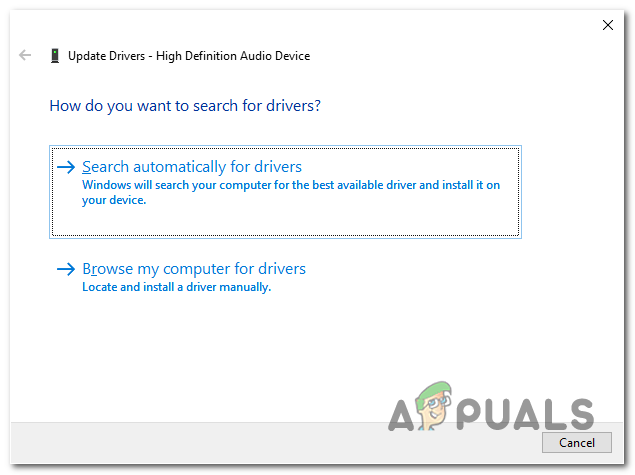
Updating audio drivers using device manager - Click on Search Automatically for drivers.
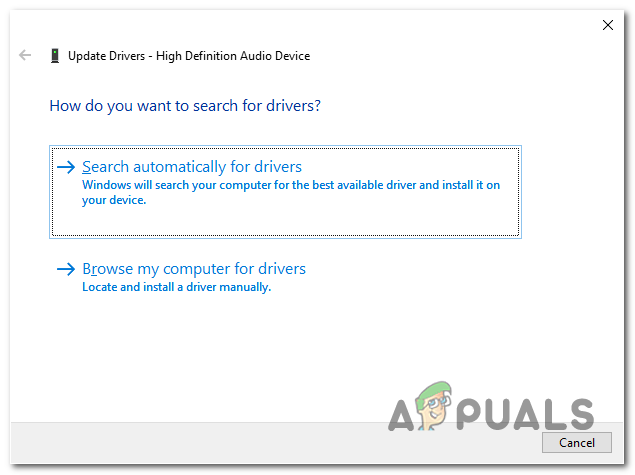
Updating audio drivers using the windows device manager - Once updated, restart your computer.
4.2 Using the manufactures website
Another way of updating your computer’s sound drivers is to update using the manufacturer’s website manually, follow these steps to update your audio drivers:
- Visit your computer’s manufacturer’s website to download the latest version of sound drivers, we have listed hyperlinks to a few widely used manufacturer’s websites for your ease:
Click here if you’re an Intel user
Click here if you’re an Asus user
Click here if you’re an HP user
If your computer’s manufacturer was not listed, simply google their website to navigate to the support centre. - Once downloaded, Open the file and proceed with the straightforward installation procedure.
5. Verify Game files
During the installation process, some of the game files might go either missing or get corrupted. This corruption in game files can lead to many problems, the issue we face being one of those problems. To verify game file integrity, follow these straightforward steps:
- Open Steam, and locate Stray in the panel on the left side of your screen.
- Right-click on stray and click on Properties.

Verifying game file integrity - In the new window that popped up, Click on Local files.
- Now, Click on Verify Integrity of game files.
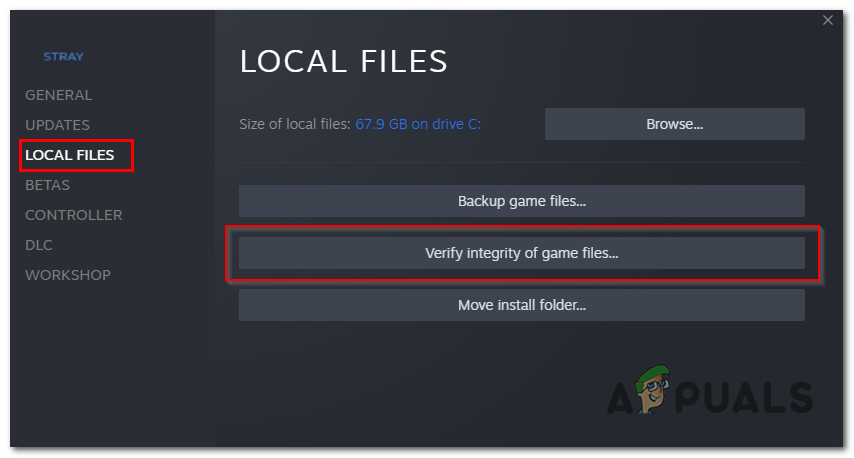
Verifying game file integrity - Wait for a while till it finishes processing.
Once done, Try relaunching stray. If the issue continues, hop on to the next step.
6. Disable spatial sound
Reportedly, Disabling spatial sound settings in windows has helped multiple users to fix this issue. Our assumptions say it has something to do with the stray’s native spatial sound conflicting with the window spatial sound setting. Follow these steps to disable the spatial sound on your windows computer:
- Press the Windows key on your keyboard to open the windows start menu, and click on the Settings icon.

Disabling spatial sound - Click on the System settings box.
- Now, Click on the Sound settings situated on the left panel.
- After that, Click on Device properties.

Disabling spatial sound - Under the Spatial sound heading, click on the dropdown menu to open it.
- Turn off spatial sound.
Once done, try launching stray; if the issue presumes, continue to the next step.
7. Disable or Disconnect External microphone
Reportedly, disabling or disconnecting your external microphone has been of help to several users, to do so, simply plug out your Microphones input cable or follow these steps to disable your microphone via windows settings:
- Right-Click on the Sound icon present on the bottom-right of your screen as shown in the image.

Disabling microphone using windows settings - Click on Open Sound Settings.
- In the newly opened window, click on the Recording tab in the navigation menu.
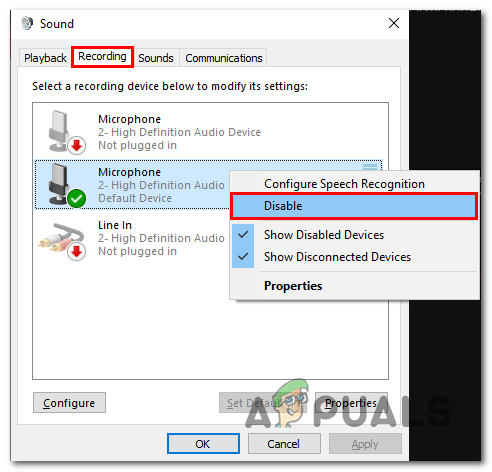
Disabling microphone via windows settings - Right-Click on your Primary Microphone and click on Disable.
- Hit the Ok button.
Once disabled, try launching stray after you have disabled your external microphone or disconnected it. If the issue continues, jump to the next step.
8. Disable Handsfree-Telephony
If you’re using a wireless or Bluetooth-enabled device, windows-provided service may compromise your audio experience. It has been discovered that the hands-free-telephony service that allows users to take calls using their headphones makes the audio quality choppy and stuttery. Follow these steps to disable this service on your computer:
- Press the Windows key to open the start menu; In the start menu, search bar type Control panel.
- Click on Hardware & Sound.

Disabling telephony services - Now, Click on Device and Printer.
- Right-Click on your Primary audio device.

Disabling telephony services - Click on Properties.
- In the navigation menu, Click on Services.
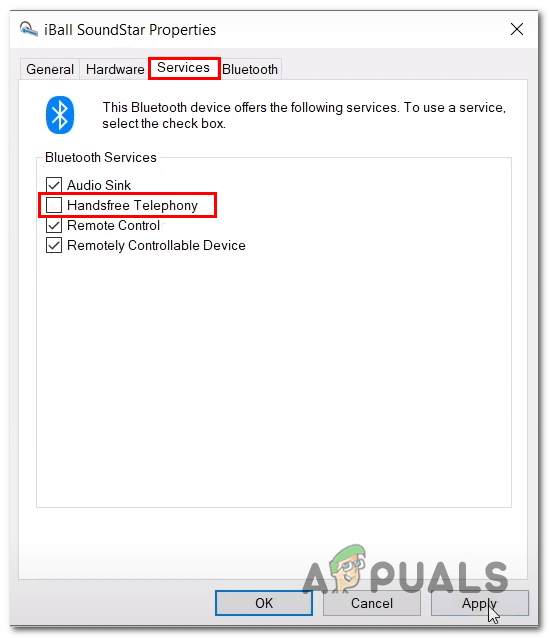
Disabling telephony services - Uncheck the Handsfree telephony settings.
- Hit the Ok button
Once you have disabled the service, restart your computer.
9. Update Windows.
The windows version you are currently using might not be stable; it is advised to keep your computer up-to-date. Follow these straightforward steps to update your windows to the latest build:
- Press the Windows key to open the windows start menu.
- Click on the Settings icon to open the windows settings.
- Click on Update and Security.

Updating windows to the latest version - Now, Click on Check For Updates, and wait for a while.
- Once finished processing, Install any available updates.
Once the installation finishes processing, Reboot your computer.





